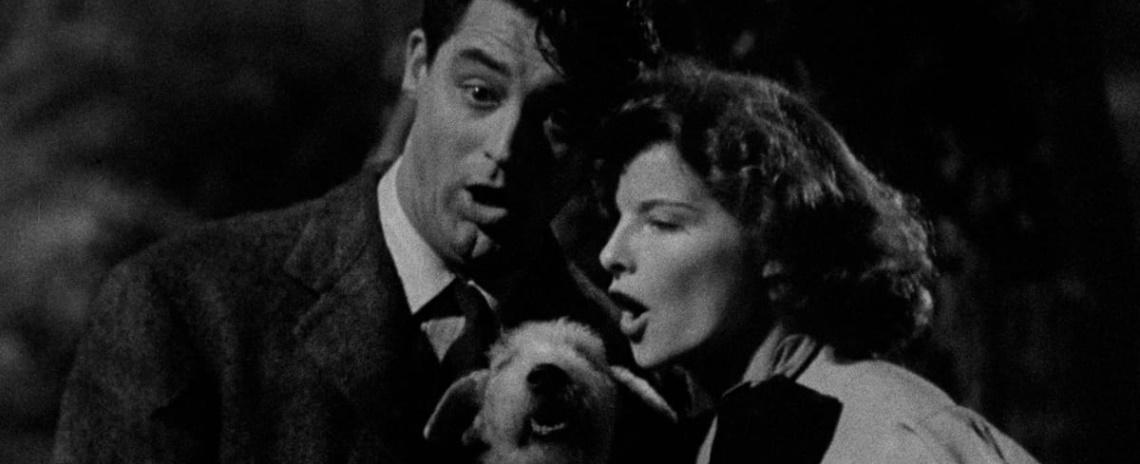With the release of Bringing Up Baby in 1938, director Howard Hawks had brought to life the greatest romantic-comedy pairing in the (admittedly short) history of the art form thus far. It’s no hyperbole: Cary Grant, playing a bumbling but well-meaning paleontologist on the verge of a marriage that has taken the backseat to his search for the last piece to an enormous dinosaur skeleton, and Katharine Hepburn, embodying a playful free spirit who wreaks havoc everywhere she goes, are the most infectiously joyous coupling the screwball subgenre has ever seen, both then and now. Shockingly, audiences in 1938 absolutely hated it. Critics had nothing but praise for the film, but that didn’t help with ticket sales. Bringing Up Baby couldn’t even turn a profit on its paltry million-dollar budget, and Hepburn was immediately dubbed box-office poison by the Independent Theatre Owners of America. Imagine that: A legion of movie-theater operators outright condemning an Oscar-winning actress.
It wasn’t until years later — boosted by Hepburn’s success post-The Philadelphia Story (1940), a Bringing Up Baby rerelease in the early ’40s, and television airings in the ’50s (and now an impeccable release by the Criterion Collection) — that moviegoers began to appreciate Bringing Up Baby for what it is: a pinnacle of the genre, a standout of the time, and a real highlight of the medium. Clearly, all it took was for people to actually watch the film. From there, Grant and Hepburn’s charm takes control. David Huxley (Grant) is just the kind of lovable dork that enraptures the viewer from the first moment he appears. He has a lot on his plate, and it’s starting to get a bit overwhelming: There’s a brontosaurus’ intercostal clavicle to find, his own wedding to attend, and a potential million-dollar donor to impress, and it’s all piling up precariously. The arrival of Susan Vance (Hepburn) just makes his situation worse, with her playing his ball out on the golf course the day before his wedding.
As it turns out, this encounter proves to be quite fortuitous: Susan’s brother has gifted her a leopard named Baby, and — mistaking him for a zoologist — David is the only one she feels can aid in the delivery of the animal safely to her farm in Connecticut. The leopard is tame, but only when it’s listening to its favorite song, “I Can’t Give You Anything but Love.” Susan goes to extreme (and hilarious) lengths to keep David from running off to get married, partially because she desperately needs his assistance delivering Baby, but mainly because she’s fallen completely in love with him in the process of trying to coerce him into assisting her with the leopard. What follows is a jubilant romp involving a leopard, a dino bone, a circus, a robbery, and even wealthy donor Elizabeth Random (May Robson) herself.
As setup like this sounds pretty inane, like the frivolous and relatively low-stakes situational comedy one might expect to find in a lesser Happy Madison production today — the sort of direct-to-Netflix production that even Kevin James is too good for, reserved specifically for David Spade or Rob Schneider. Assuredly, Bringing Up Baby is just about the furthest thing from this. Still, audiences were not entirely to blame for wanting to avoid something as silly-sounding as this: Apart from Twentieth Century (1934), Hawks’ best romantic-comedy work was ahead of him, with certified hits like His Girl Friday (1940), Ball of Fire (1941), and Gentlemen Prefer Blondes (1953). Grant had only just begun to dip his toe into rom-coms, with his first major efforts — Norman Z. McLeod’s Topper (1937) and Leo McCarey’s The Awful Truth (1937) — less than a year old at the time of Bringing Up Baby’s release. Even Hepburn wasn’t exactly a draw for audiences in 1938, fresh off a string of critical and commercial failures that stretched back to 1934.
Whether 1938 or 2021, appreciating Bringing Up Baby for the incontestable masterwork that it is simply requires one to sit down and watch it. This might sound obvious, but it bears repeating: Judging a book by its cover (or, in this instance, a movie by its poster, which goofily portrays Grant and Hepburn in animated form feeding Baby in a high chair) will not do anyone any favors here. With a script fine-tuned to Hepburn’s sensibilities and stylings, a go-for-broke performance from Grant that feels so gleefully uncharacteristic of an Old Hollywood hunk like him, and fast-paced direction from Hawks to hold it all together with remarkable dexterity, viewers will ultimately be won over by Bringing Up Baby once they give it a chance.
Although its stars and filmmaker were unable to enjoy the movie’s success at the time, echoes of Bringing Up Baby permeate throughout the pop culture of the ’70s, ’80s, and ’90s — from Peter Bogdanovich’s extended homage to Grant and Hepburn’s characters in his film What’s Up, Doc? (1972) to the future of the Manic Pixie Dream Girl trope that Hepburn’s character exemplifies to the entire persona of Ross Geller on NBC’s Friends (1994-2004), Bringing Up Baby’s fingerprints continue to cover comedy’s blueprints to this day. Come to think of it, perhaps comedy is a brontosaurus skeleton and Bringing Up Baby is the intercostal clavicle. With the last great romantic or screwball comedy increasingly difficult to name, is it too much to ask for a paleontologist — i.e., a filmmaker — to seek out the missing piece to the skeleton that is the modern studio comedy?
Rating: A-
Further Viewing: Twentieth Century (1934), Sylvia Scarlett (1935), The Awful Truth (1937), Holiday (1938), The Philadelphia Story (1940), His Girl Friday (1940), Ball of Fire (1941), I Was a Male War Bride (1949), Monkey Business (1952), Gentlemen Prefer Blondes (1953), Man’s Favorite Sport? (1964), What’s Up, Doc? (1972)


